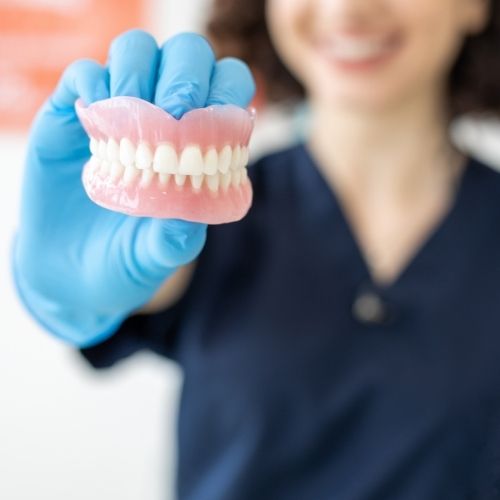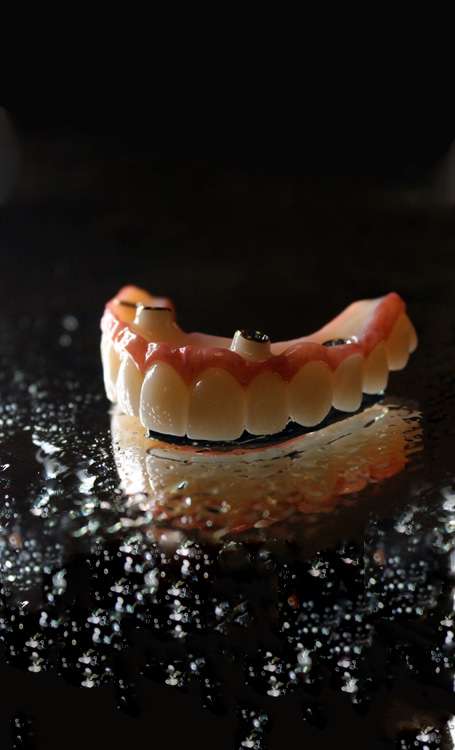Dentures

Dentures: Full & Partials in Glenview, IL
Full or partial dentures can be a helpful restorative option for people who are missing several or even all of their teeth. Dentures are designed to be worn every day and removed at night. They are designed to sit over the gums and around any existing teeth. However, it is important to note that dentures cannot serve as a replacement for teeth; rather, they are an alternative to the absence of teeth.
Dentures are an alternative to dental bridges and dental implants. Dentures can also be placed over implants and abutments. This is called an over-denture and is an excellent combination treatment alternative with great results.
What are the steps involved in making a denture?
Dentures require several steps, as well as several visits to the office to complete, as well as for adjusting the denture for the best possible fit. A typical full or partial denture takes about X weeks for the full process to be complete.
Step 1:
Step 2:
Step 3:
Step 4:
If you need a tooth extraction, your dentist may recommend an immediate denture which is also sometimes referred to as a "practice denture." Patients often wear these to help them get used to having dentures and also as a temporary replacement during the extraction healing process which can sometimes take weeks or months. Your dentist will take an impression of your teeth prior to the extraction and these impressions will be used by a dental lab to create your denture. With an immediate denture, your denture will be ready to wear right after your extractions have been completed. Immediate dentures typically require adjustment and relining because they were made before any extractions, which can change the shape of your gums and jaw.
The cost of dentures can vary between immediate, full, and partial dentures, and if the denture is for one arch or for both.
If you have dental insurance, your coverage may include a new or replacement set of dentures. Our staff is happy to review your coverage with you to ensure you are maximizing your insurance benefits while minimizing any out-of-pocket expenses.
Dentures are included in our full range of services and can be made by any Glance Dental doctor in our Glance dental location.
Generally, dentures should be worn during waking hours and removed only at night for cleaning and storage. The more you wear your denture, the more quickly you will adapt and adjust to having them. Upper dentures usually fit snugly using natural suction. The lower denture may feel looser because of the shape of the jaw and other factors. You may need to use adhesive to hold your denture firmly in place after a few weeks, but if you experience persistent issues with sore spots or the fit and feel of a denture you had delivered by a dentist at Glance Dental, you are always welcome to come in for a free evaluation and adjustment.
Having dentures takes time to get used to and requires patience, practice, and persistence for patients to feel comfortable and at ease.
Some common adjustments include:
Speaking: You may find that you have difficulty enunciating certain words and making some sounds. This is perfectly normal, and with some practice and patience, you will be back to speaking normally and comfortably.
Eating: You will need to get used to using a side-to-side motion to chew your food rather than an up and down motion. This also takes practice and persistence to master. Many people who have dentures have found they can generally eat the foods they were able to eat before, especially when making small adaptations such as cutting food into smaller pieces to make it easier to chew.
Physical Appearance: Dentures are an alternative for the absence of teeth, and are made of plastic and acrylic. This means that in general, they look and feel different than a dental bridge, for example.
Other issues that may arise with a full or partial denture can include food getting under the denture, loose dentures, or a general feeling of fullness in your mouth. Typically, these issues will clear up with future adjustments, along with practice and time to adapt to your denture.
Overdentures
In some cases, four or more dental implants may be placed in the jaw. A denture is made that fits over the healing implants, so you are able to wear your dentures during the healing period. Once these implants have healed, the denture can be adjusted to clip directly onto the dentures. The dentures are held firmly in place until you are ready to remove them.
In addition to a major improvement in the comfort, fit, and feel of an implant/overdenture combination, dental implants help to slow or even stop the progression of bone loss over time.
Bridge Over Implants
Some patients have either had multiple implants placed or continued to add dental implants, one by one. Dental bridges and crowns can then be created with a series of fixed (non-removable) bridges that look and act like regular teeth.



